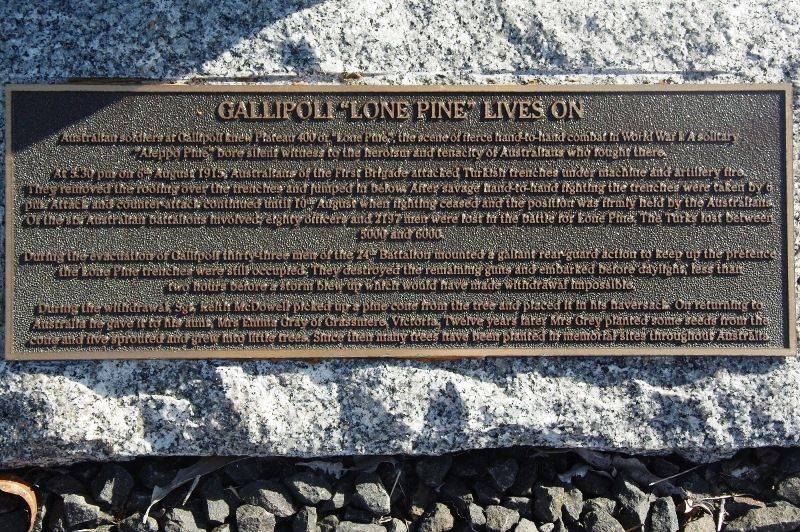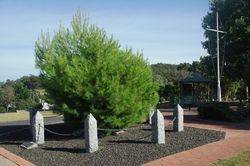
Home » Themes » Conflict » World War One
Gallipoli Lone PinePrint Page 
The pine tree commemorates those who served in World War One. Pines which are planted as a memorial to the Australian and New Zealand soldiers who fought in Gallipoli are also known as "Lone Pines" or "Gallipoli Pines", referencing the original tree.
The Lone Pine was the name given to a solitary tree on the Gallipoli Peninsula in Turkey, which marked the site of the Battle of Lone Pine in 1915 during World War One and it was the sole survivor of a group of trees that had been cut down by Turkish soldiers who had used the timber and branches to cover their trenches.
The tree was obliterated during the battle; however, pine cones that had remained attached to the cut branches over the trenches were retrieved by two Australian soldiers and brought home to Australia. Private Thomas Keith McDowell, a soldier of the 23rd Battalion brought a pine cone from the battle site back to Australia, and many years later seeds from the cone were planted by his wife's aunt Emma Gray of Grassmere, near Warrnambool, Victoria and five seedlings emerged, with four surviving. These seedlings were planted in four different locations in Victoria: Wattle Park (May 8, 1933), the Shrine of Remembrance in Melbourne (June 11, 1933), the Soldiers Memorial Hall at The Sisters near Terang (June 18, 1933) and Warrnambool Botanic Gardens (January 23, 1934).
Another soldier, Lance Corporal Benjamin Smith from the 3rd Battalion, also retrieved a cone and sent it back to his mother (Mrs McMullen) in Australia, who had lost another son at the battle. Seeds from the cone were planted by Mrs McMullen in 1928, from which two seedlings were raised. One was presented to her home town of Inverell (New South Wales) and the other was forwarded to Canberra where it was planted by Prince Henry, Duke of Gloucester at the Australian War Memorial in October 1934.
The Shrine of Remembrance's lone pine was felled in August 2012 and the timber used as part of a remembrance project, after a disease known as Diplodia pinea or blue stains fungus as it commonly called killed it.
Melbourne Legacy and the Yarralumla Nursery in Canberra have grown seedlings sourced from the trees at the Shrine of Remembrance and the Australian War Memorial respectively, which they have presented to schools as well as ex-service and other organisations throughout Australia.
Location
| Address: | Munje Street, Pambula Cemetery, Pambula, 2549 |
|---|---|
| State: | NSW |
| Area: | AUS |
| GPS Coordinates: | Lat: -36.929693 Long: 149.883565 Note: GPS Coordinates are approximate. |
Details
| Monument Type: | Tree |
|---|---|
| Monument Theme: | Conflict |
| Sub-Theme: | WW1 |
Dedication
GALLIPOLI "LONE PINE" LIVES ON
Australian soldiers at Gallipoli knew Plateau 400 or "Lone Pine" the scene of a fierce hand-to-hand combat in World War 1. A solitary "Aleppo Pine" bore silent witness to the heroism and tenacity of Australians who fought there.
At 5.30pm on 6th August 1915, Australians of the First Brigade attacked Turkish trenches under machine gun and artillery fire. They removed the roofing over the trenches and jumped in below. After savage hand-to-hand fighting the trenches were taken by 6 pm. Attack and counter attack continued until 10th August when fighting ceased and the position was firmly held by the Australians. Of the six Australian battalions involved eighty officers and 2197 men were lost in the battle for Lone Pine. The Turks lost between 5000 and 6000.
During the evacuation of Gallipoli thirty- three men of the 24th Battalion mounted a gallant rear-guard action to keep up the pretence the Lone Pine trenches were still occupied. They destroyed the remaining guns and embarked before daylight, less than two hours before a storm blew up which would have made withdrawal impossible.
During the withdrawal, Sgt. Keith McDowell picked up a pine cone from the tree and placed it in his haversack. On returning to Australia he gave it to his aunt, Mrs Emma Gray of Grassmere, Victoria. Twelve years later Mrs Grey (sic) planted some seeds from the cone and five sprouted and grew into little trees. Since then many trees have been planted in memorial sites throughout Australia.






